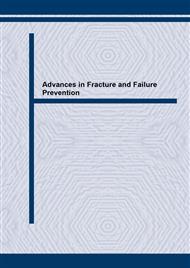p.325
p.331
p.337
p.345
p.351
p.357
p.363
p.369
p.375
Relation between Stress Intensity Factor of a Small Edge Interface Crack and Intensity of Free-Edge Stress Singularity of Bonded Dissimilar Materials
Abstract:
When two materials are bonded, the free-edge stress singularity usually develops near the intersection of the interface and the free-surface. Fracture in bonded dissimilar materials may therefore occur from an interface crack which develops at the intersection of interface and free-surface. Free-edge stress singularity is very important in the evaluation of strength of bonded dissimilar materials. In this study, the relationship between the stress intensity factor of a small edge crack on interface of bonded dissimilar materials and the intensity of free-edge stress singularity of bonded dissimilar materials with no crack under external mechanical loading was investigated numerically by using the boundary element method. The relationship was also investigated theoretically by using the principle of superposition. The results of numerical analyses were compared with those of theoretical analyses. It was found that stress intensity factors of small edge crack on interface K1 and K2 were proportional to the intensity of free-edge stress singularity of bonded dissimilar materials Kσ without crack irrespective of the combination of materials. The numerically determined proportional coefficient between K1 and Kσ agreed well with the theoretical one, and was not affected by crack length when proper normalizations were applied. From these results, it is suggested that stress intensity factor of small edge crack on interface can be used as a strength criterion of interface of bonded dissimilar materials.
Info:
Periodical:
Pages:
351-356
Citation:
Online since:
April 2004
Authors:
Price:
Сopyright:
© 2004 Trans Tech Publications Ltd. All Rights Reserved
Share:
Citation:


